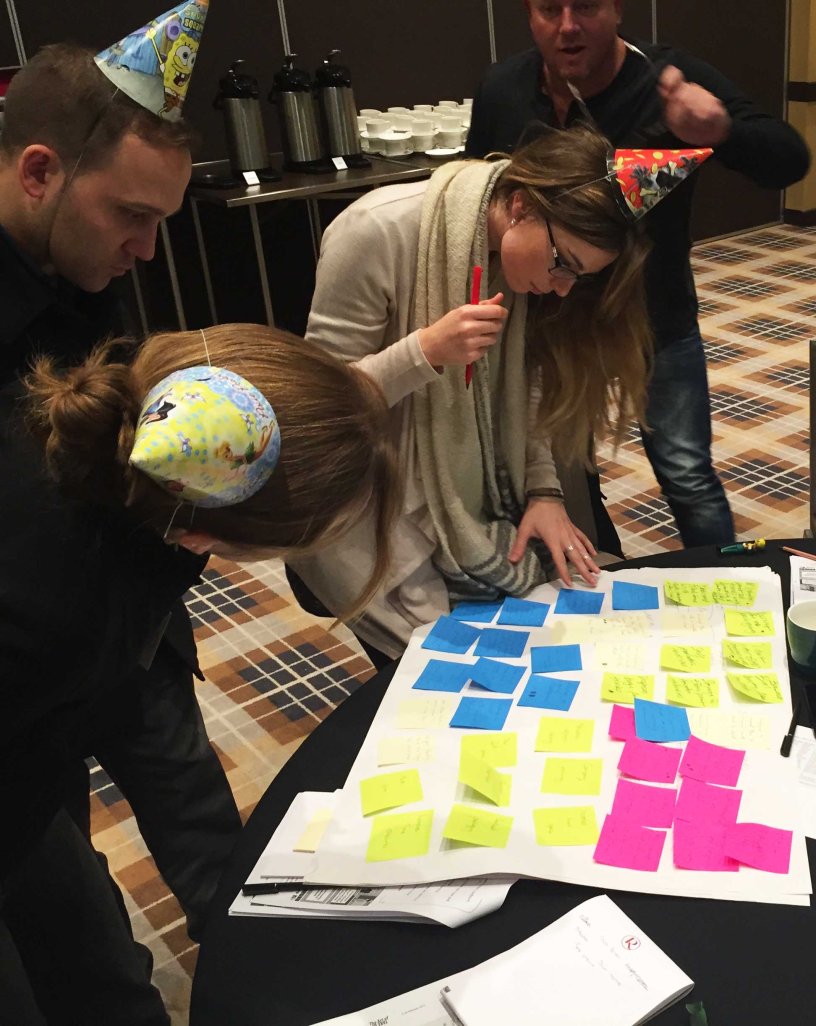Brainstorming is one of the most common things we do in workshops. It’s the moment when we gather the extraordinary brain power of groups to generate solutions that individuals would struggle to create alone. It’s also how we practice inclusiveness, so that groups take ownership of solutions.

Brainstorms are also one of the worst things we do.
Why?
Because there are plenty of ways poorly facilitated brainstorms inhibit creativity and innovation, waste time, reinforce groupthink, or lead to a few extroverts dominating the rest of the participants so that the answers are more about personalities that the merit of ideas.
So what makes a great brainstorm?
There’s a surprising number of factors to think about and I’ve always tried to list the underlying principles in my training workshops, but I’ve gradually realised the easiest way is simply to give facilitators a script to follow – one they can freely modify and make their own.
Here’s the latest version of the script I use in the workshops I facilitate. It’s taken more than a decade of experimentation to reach this point. I’ve used it a lot.
Hope you find it useful too.
BTW, I’ve left out the two biggest quality controls for great brainstorms, the DIVERSITY OF PARTICIPANTS, and HOW TO INFORM AND INSPIRE them before the brainstorm begins – that’s for another post.
P.S. There’s an excellent Youtube video from Google’s Creative Skills for Innovation Lab that describes a similar process. (Note that it uses a funky 3D Youtube format that doesn’t work correctly in Safari even though you can still view it).
How to instruct a brainstorm
The set up: Tables of 5, each with a table facilitator.
Materials: Post-it notes. Marker pens. Flip-chart paper.
STAGE 1: Set-up and first layer of ideas [around 10 minutes]
1) “Welcome to this brainstorm, which aims to answer the following question: [insert an open, positive question, like “What would make the biggest difference to [a desired future].”
2) “I’m going to create 2 [to 5] minutes of silence to for each person to write down their answers. By ‘silence’ I mean complete silence so each person can think privately.”
3) “Write one idea per Post-it note. Print each idea big and clear using a marker pen.” [show example]
4) “Write as many ideas as possible, even if they’re bad or you’re unsure about them or they might only make a little difference. Go for the maximum number of ideas you can think of.”
5) “Be concrete and specific. We’re looking for word pictures that can be easily imagined. Avoid abstractions like ‘ownership’ or ‘engagement’. Talk about things you can see, touch, taste.”
“Table facilitators: when you spot a fuzzy idea, be prepared to say ‘Yes, but what would that look like? Or ‘Yes, but how could we do that?’ Practice doing that now, so you can get in the groove.”
6) “Then simply stick your ideas down, offering a few words as you go. There is no need to justify or explain your ideas, simply state them.”
7) “Do not judge other people’s ideas. But feel free to make positive ‘Yes, and…’. comments that add to them.”
STAGE 2: Add a playfulness rule [around 5 minutes]
Once all the Post-it notes are down, which should only take 2 to 5 minutes, repeat the question, except this time add a playfulness rule. This helps draw out those seemingly unsafe, left-field ideas that are often essential to create solutions to problems which aren’t being solved by business as usual.
8) “Now please repeat the same question, except this time we’ll add a playfulness rule* to enhance your creativity: [insert the playfulness rule here].
“Once again, let’s practice 2 minutes of silence to gather our thoughts. Then just stick the new ideas down amongst the first set.”
* Examples of playfulness rules (choose just one):
“Imagine you’re eight years old.”
“Your manager should think you’ve lost the plot.”
“You can break the rules of physics.”
“You have unlimited time/money/volunteers to help you implement the idea.”
“No matter what idea you come up with, your funder with love it.”
“You have a magic wand.”
STAGE 3: Prioritisation [around 10 minutes]
9) “Let’s prioritise these ideas with dots. Every individual person has 10 dots to invest as they see fit. Individuals can spend up to 3 dots on any one idea. This is also done in complete silence. To make dots just pick up a marker pen and put big dots next to the ideas you like.” [demonstrate]
10) “It’s good to think about spending your dots on ideas that make a big impact and which you can imagine seeing in practice, but the choice is entirely up to you.”
11) “Then add up the dots. The ideas that are clearly ahead on dots represent your group’s preferred solution.”
STAGE 4: Shaping up [around 30 minutes]
12) “Now spend time shaping these ideas into a coherent plan, which you should present as a drawing.” [Allow 10-20 minutes]
13) “Each team selects a spokesperson and presents their solution.” [3 mins per team]
—————————————————————
An interesting variation: ‘asynchronous brainwriting’ – that is, rotating between 8-minute individual silent writing sessions and 3-minute group sessions, where group members simply read over each other’s ideas (but don’t comment). In an experiment it doubled the rate of idea generation. Source: Fast CoDesign

Hi Les, thanks for the article. I like the reminder to layer the brainstorming process and not just think everything has been captured in one layer. I particularly like the addition of permission to have fun and think outside the box. In my local government setting, we are inclined to take things (mostly ourselves) far too seriously and so miss out on innovation and new ideas.
cheers
Tracey
Great little piece and a reminder. Love even the reminder to share our practices.